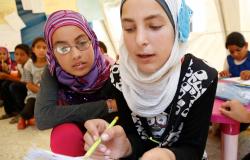Implementing an Intersectional Approach in the Peace-Building Field

Arnub Farooqi and Fenna Slenter call for intersectionality to be acknowledged and mainstreamed into peace-building initiatives.
After fleeing from Syria to Jordan, the violence started for Sura. Life as a refugee without work or income is unbearable, which leads her husband to take it all out on her. He feels helpless: his children ask him for things he cannot provide. Sura shares that feeling and even forgives him for his violence at times, but there are days when she knows she cannot take it anymore. A healthcare clinic has been her saviour, acting as a safe space where she not only receives physical but also mental health care.
This is just one of countless true stories surrounding GBV and, by extension, intersectionality. Learn more about Sura here.
Much like the broader and more widely understood humanitarian field, the peace-building field is one that values human life, actively promoting the well-being of humankind on an individual basis and as a whole, regardless of one’s race, ethnicity, religion, sex, background or any affiliation. Through innovative approaches taken by organisations such as Generations For Peace, peace-building advocates and actors must look beyond people’s differences to offer everyone an equitable chance at human welfare.
However, the understanding that we are all entitled to respect and dignity does not take away the fact that every person is different and faces their own unique set of vulnerabilities. Although the idea of treating everyone as an equal should be the starting point of any peace-building mission, it is important to realise that this approach does not fully allow us to properly support those we are seeking to help. Ignoring the variety of aspects that make up not only a person’s identity, but also the vulnerabilities that often arise from it can limit how effective peace-building practice can be, as a one-size-fits-all approach may not meet the unique needs of a population, let alone the individuals that compose it.
This is where intersectionality comes in.
Intersectionality describes the complexity of intertwined connections between identity, socio-economic status, and systems of power that make up how we fit into the world around us. The idea reveals that we do not fit into a single neat box, but rather maintain identities composed by the context that exists within and around us. Through the framework outlined by intersectionality, we know that we are not just black or white, male or female, rich or poor, but instead belong to many different communities at once. Black women, for example, face a set of challenges that are uniquely different from those faced by white women; similarly, a disabled man in the upper class confronts different challenges than a disabled man from a low- or middle class.
Intersectionality was first coined by Kimberlé Crenshaw almost 30 years ago. In her reasoning, the term explains the unique challenges that, for example, a black woman faces by positioning her on the intersection of what Crenshaw calls ‘racism-road’ and the ‘sexism-road,’ on which the woman might simultaneously experience both marginalisations.
Intersectionality should therefore be considered an integral part of good peace-building practice: an understanding of the unique and interwoven sets of challenges that impact a vulnerable person is essential to provide them with the right kind of aid or programme.
The need for an intersectional approach is apparent in many contexts, and is easily identifiable within the context of conflict-related displacement.
As a result of the ongoing Syrian conflict, over 650,000 Syrians have sought refuge in Jordan since 2011, mostly in urban and rural communities, often near the border. Displaced persons face a set of unique challenges: next to experiencing emotional and economic hardship, they also face difficulties in acclimatisation and integration into their host communities. Refugee women and girls, in particular, are exposed to an increased risk of multiple forms of gender based violence (GBV), including abuse by intimates, forced and early marriage, and sexual violence. These specific challenges are faced by refugee- or internally displaced women more than by their male counterparts. These women thus maintain two primary, intersecting identities: they are both displaced and female.
At Generations For Peace, as with any other organisation addressing marginalised communities, intersectionality is a highly relevant topic. Within its peace-building programmes, both participants and volunteers delivering those programmes deal with all kinds of intersecting identities, which often lie at the root of a given conflict.
The organisation is proud to implement programmes and oversee initiatives like this one that specifically address intersecting identities, and it has recently taken another step in pursuing an intersectional approach through the implementation of a new partnership with UN Women. The agreement and ensuing programme specifically recognises this need for an intersectional approach regarding the challenges facing Syrian refugee women and girls like Sura within Jordanian communities. Although the programme addresses both Syrian refugees and vulnerable Jordanian youth, both male and female, it is emphasised that there will be a distinct focus on gender sensitivity and equality, as girls and women and boys and men experience violence differently.
Through this partnership, Generations For Peace is broadening its understanding of what intersectionality can look like and how it might affect the environment of its programmes and participants – both necessary steps in the larger process of adopting an effective and overarching intersectional model. For a woman like Sura, such a model means not only receiving physical and economic aid, but also having access to a safe space with mental guidance for the gender based violence she faces each day.
Sura’s story is not unique: many men, women, and children can be categorised into a range of overlapping identity groups, lending to the necessity of an intersectional approach. The following may be helpful when adopting such an intersectional model in peace-building efforts:
1. Recognise that peace-building practice is not a universal, agreed-upon concept; instead, it varies depending on the needs of the people being addressed. It can change based on gender, religion, or culture, making it important to provide services that match the intersecting needs of the people you are working with. Making peace-building practice intersectional helps to ensure that vulnerable people are properly addressed and helped.
2. Take the time to conduct thorough conflict and context analyses in order to learn the details surrounding the main challenges facing each community, the intersecting identity groups most affected by them, and those in a position to best contribute to peace-building efforts. In Sura’s case, the already existing healthcare clinic functioned as a channel through which challenges such as hers could be addressed. However, channels are present in some form in every community: from schools and youth centres to religious institutions, peace-building efforts can utilise these already trusted spaces to implement specific and intersectional approaches.
3. Finally, empower the audience you are trying to address to become involved in the decision-making process whenever possible, in order to gain an intersectional perspective. This means that if you are working with displaced people, engage with a diverse group living in the refugee camp or host community to hear their thoughts on what could be changed and how. For example, you may want to speak to women like Sura, as well as children and youth or people with disabilities, who may offer a unique perspective on how they experience life in the given setting.
Arnub Farooqi is a Research Analyst and Technical Writer currently based in Amman, Jordan, whose work centers on youth, curriculum development and education, child protection, refugees, and gender.
Fenna Slenter is a Research Writer who is currently pursuing a degree in Political Science and Administrative Law at Utrecht University in the Netherlands.
Image credit: DFID via Flickr (CC BY 2.0)


